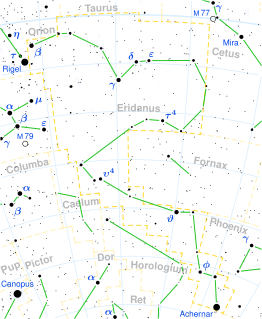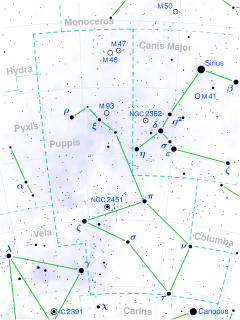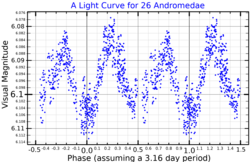
Zeta Andromedae is a star system in the constellation Andromeda. It is approximately 189 light-years from Earth.

8 Andromedae, abbreviated 8 And, is a probable triple star system in the northern constellation of Andromeda. 8 Andromedae is the Flamsteed designation. It is visible to the naked eye with an apparent visual magnitude of 4.82. Based upon an annual parallax shift of 5.7 mas, it is located about 570 light years from the Earth. It is moving closer with a heliocentric radial velocity of −8 km/s.
41 Andromedae is a single star in the northern constellation of Andromeda. 41 Andromedae is the Flamsteed designation. It is bright enough to be faintly visible to the naked eye, having an apparent visual magnitude of 5.04. Based upon an annual parallax shift of 16.4 mas, it is located 198 light years away. The star is moving further from the Earth with a heliocentric radial velocity of +10 km/s and it has a relatively high rate of proper motion, traversing the celestial sphere at the rate of 0.171″ per year.
24 Cancri is a triple star system in the constellation Cancer. The system is located about 226 light-years away, based on its parallax. The system has a combined apparent magnitude of 6.5, and the two components A and B are separated by 5.7″.
p Eridani is a binary star system in the constellation of Eridanus whose distance from the Sun is 26.7 light-years based upon parallax. It was found to be a double star in December 1825 by James Dunlop in Australia at his home at Paramatta, now spelt Parramatta. It is visible to the naked eye as a dim, orange-hued star. The system is moving further from the Earth with a heliocentric radial velocity of about +20 km/s.
HD 81040 is a star in the equatorial constellation of Leo. With an apparent visual magnitude of +7.73 it is too dim to be visible to the naked eye but can be viewed with a small telescope. The star is located at a distance of 112 light years from the Sun based on parallax. It is drifting further away with a radial velocity of +49 km/s, having come to within 48 light-years some 527,000 years ago.
HD 11506 is a star in the equatorial constellation of Cetus. It has a yellow hue and can be viewed with a small telescope but is too faint to be visible to the naked eye, having an apparent visual magnitude of 7.51. The distance to this object is 167 light years based on parallax, but it is drifting closer to the Sun with a radial velocity of −7.5 km/s. It has an absolute magnitude of 3.94.
HD 4113 is a dual star system in the southern constellation of Sculptor. It is too faint to be viewed with the naked eye, having an apparent visual magnitude of 7.88. The distance to this star, as estimated by parallax measurements, is 137 light years. It is receding away from the Sun with a radial velocity of +5 km/s.
HD 115404 is a binary star system located in the constellation Coma Berenices. Parallax measurements made by Hipparcos put the system at 36 light-years, or 11 parsecs, away. The combined apparent magnitude of the system is 6.52, with the magnitudes of the components being 6.66 and 9.50.
HD 90089 is a star located in the northern circumpolar constellation Camelopardalis. With an apparent magnitude of 5.25, it is faintly visible to the naked eye under ideal conditions. This star is located relatively close at a distance of 75 light years, but is drifting away at a rate of almost 8 km/s.
HD 126614 is a trinary star system in the equatorial constellation of Virgo. The primary member, designated component A, is host to an exoplanetary companion. With an apparent visual magnitude of 8.81, it is too faint to be seen with the naked eye. The system is located at a distance of 239 light years from the Sun based on parallax measurements, but is drifting closer with a radial velocity of −33 km/s.
V Cephei is a white main sequence star in the constellation Cepheus. It only varies slightly by 0.03 of a magnitude. It was suspected of being variable by American astronomer Seth Carlo Chandler noting in 1890 that it varied by 0.7 magnitude but that it needed more confirmation. Subsequent observers were divided in whether they noted variability or not. A subsequent study with photoelectric photometry showed no variability.

f Eridani is a binary, or possibly a triple, star system in the equatorial constellation of Eridanus, consisting of stars HD 24071 and HD 24072. They share a single Hipparcos catalogue entry, HIP 17797, but have separate Bright Star Catalogue listings, HR 1189 and 1190. f Eridani is the Bayer designation of the pair.
HD 106515 is a binary star in the constellation of Virgo.

1 Puppis is a single star in the southern constellation of Puppis. It lies in the northern part of the constellation at a distance of about 790 ly, east of Aludra in Canis Major and just north of the white supergiant, 3 Puppis. This object is visible to the naked eye as a faint, red-hued star with an apparent visual magnitude of 4.59. It is moving further from the Earth with a heliocentric radial velocity of +32.4 km/s.

31 Cygni, also known as ο1 Cygni, Omicron1 Cygni, or V695 Cygni, is a triple star system about 750 light years away in the constellation Cygnus.

9 Ceti is a star in the equatorial constellation of Cetus. It has the variable star designation BE Ceti, while 9 Ceti is the Flamsteed designation. It has an apparent visual magnitude of 6.4, which is below the limit that can be seen with the naked eye by a typical observer. Based upon parallax measurements, this star is 69.6 light years away from the Sun.
HD 64307, also known as HR 3075, is a solitary, orange hued star located in the northern circumpolar constellation Camelopardalis. It has an apparent magnitude of 5.35, allowing it to be faintly seen with the naked eye. Based on parallax measurements from the Gaia spacecraft, The object is estimated to be 690 light years distant. It appears to be receding from the Sun, having a heliocentric radial velocity of 34 km/s.
HD 37289, also known as HR 1916, is a solitary, orange hued star located in the northern circumpolar constellation Camelopardalis. It has an apparent magnitude of 5.61, making it faintly visible to the naked eye under ideal conditions. Based on parallax measurements from the Gaia spacecraft, the object is estimated to be 308 light years distant. It appears to be approaching the Sun, having a heliocentric radial velocity of −20.7 km/s.
7 Tauri is a multiple star in the northern constellation of Taurus. It has a combined apparent visual magnitude of 5.95, so, according to the Bortle scale, it is faintly visible from suburban skies at night. Measurements made with the Gaia spacecraft show an annual parallax shift of 5.5 mas, which is equivalent to a distance of around 593 light years from the Sun.






